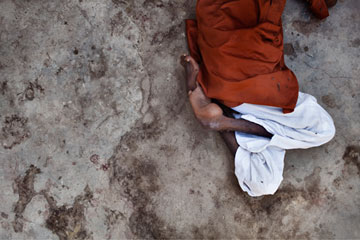
(2 of 5)
"In the garb of these vaccination campaigns," said one piece of propaganda, "the U.S. and its allies are running their spying networks." There is no truth in that, but the lie got legs in 2011 when it was revealed that in the run-up to the killing of Osama bin Laden, a Pakistani doctor masqueraded as a hepatitis-vaccine worker in an attempt to collect cheek swabs from family members in bin Laden's compound to try to confirm he was living there.
Extremists have never needed such kernels of truth to sabotage vaccine efforts, however--not when rumor mongering, much of it outlandish, can scare the public into refusing immunizations. The polio vaccine contains HIV, they are told. It's made from pig or monkey urine. It's meant to sterilize children. Whether it's because of fear of outsiders or general suspicion of anything touched by the West, the lies work.
"We are an illiterate people," says Saiful Islam, a shopkeeper in Mohib Banda, near Peshawar, in northern Pakistan. "When one person says something, we don't ask where he learned it. We just believe it." Islam believed, and when polio workers came in July, he refused to let them vaccinate his 6-month-old daughter. Now she wears pink braces with black Velcro straps on her little legs and squirms as he exercises her left foot to prevent it from curling in on itself. All viruses fight back against their eradication. Polio is the only one with a propaganda wing and an armed militia on its side.
At the Brink
By almost any measure, the rear guard protecting the poliovirus is outgunned by the forces trying to eliminate it. A lot of the progress that's been made so far is due to the efforts of Rotary International, which in 1979--the year polio was declared eradicated in the U.S.--decided to make it the mission of its then 18,000 clubs and 850,000 members worldwide to wipe out the disease everywhere. UNICEF, WHO and the U.S. Centers for Disease Control have put their muscle behind the push, and in 2007, the Bill & Melinda Gates Foundation joined in as well, spending $1 billion so far to battle the disease. "I'm very focused on impact per dollar," Gates said at a September meeting of the U.N.'s Economic and Social Council--a meeting also attended by the Presidents of all three endemic countries and U.N. Secretary-General Ban Ki-moon. "This is one of the smartest allocations of resources the world can make."
In terms of raw caseload, it's not easy to see how. When you're down to counting cases in the hundreds, you should be able to declare victory and go home--especially in a world where 34 million people are infected with HIV and 220 million have malaria. But those numbers can mislead. For one thing, for every 200 polio infections, only one results in paralysis. The rest look like nothing more than a cold or a passing fever, though the child is still spreading the virus. What's more, polio moves fast. In 2003 the disease seemed near its end until clerics in northern Nigeria halted inoculations on the basis of rumors about sterility and HIV contamination. Two years later, polio cases--nearly all of them the Nigerian strain--were raging across 16 countries throughout Asia and down to Oceania.
